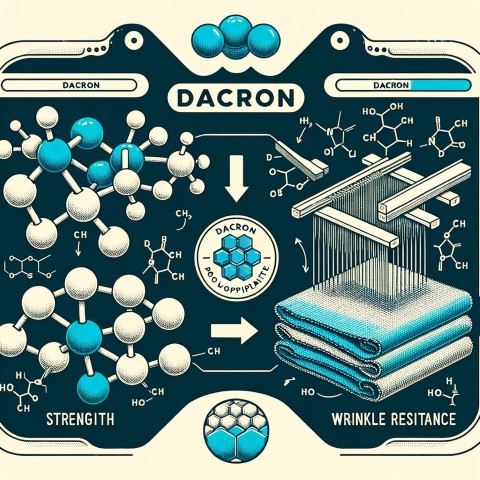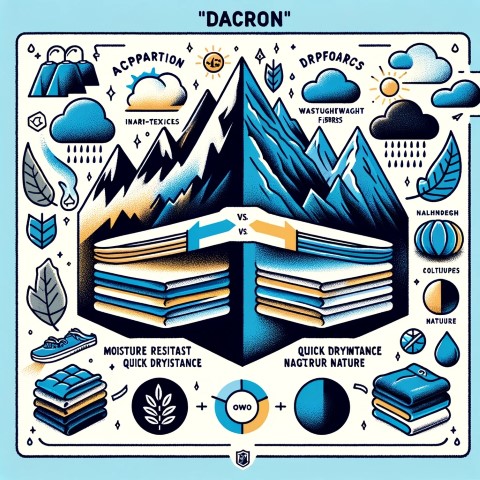What is "Dacron" - Definition & Explanation
Last Updated on: 25-Apr-2023 (1 year, 2 days ago)
Share on Facebook • Share on Twitter
Last Updated on: 25-Apr-2023 (1 year, 2 days ago)
Share on Facebook • Share on Twitter
Dacron's Secret: How This Polyester Outperforms in Textile Innovation
Dacron fibers are synthetic, meaning they are man-made rather than derived from natural sources. They are produced through a process called polymerization, in which ethylene glycol and terephthalic acid (or dimethyl terephthalate) are chemically reacted to create a polymer. This polymer is then spun into fibers, which can be further processed into various textile products.
One of the key advantages of Dacron fibers is their strength and durability. They have a high tensile strength, meaning they can withstand tension without breaking or stretching excessively. This makes Dacron ideal for applications that require long-lasting, resilient textiles, such as outdoor furniture, upholstery, and technical fabrics. Additionally, Dacron fibers have excellent resistance to abrasion, which contributes to their durability.
Dacron fibers are also known for their versatility in terms of fabric properties. They can be manufactured to have different characteristics, such as high or low stretch, stiffness, or softness, depending on the intended application. This makes Dacron suitable for a wide range of textile products, including apparel, home furnishings, industrial fabrics, and even medical textiles.
In the textile industry, Dacron fibers are used by a variety of manufacturers and brands. One prominent user of Dacron fibers is the furniture industry. Dacron is often used in upholstery fabrics and cushion fillings due to its durability and ability to maintain its shape over time. Many furniture manufacturers rely on Dacron to create comfortable and long-lasting seating options.
Another significant user of Dacron fibers is the apparel industry. Dacron is commonly blended with other fibers, such as cotton or wool, to improve the strength, wrinkle resistance, and shape retention of fabrics. It is frequently used in garments like shirts, pants, dresses, and sportswear, providing a balance of comfort, performance, and durability.
Furthermore, Dacron fibers are utilized in technical textiles, which are fabrics engineered for specialized applications. Technical textiles can be found in industries such as automotive, aerospace, construction, and healthcare. Dacron's strength, resistance to chemicals, and thermal stability make it suitable for applications such as airbags, seat belts, geotextiles, and surgical gowns.
As for manufacturers, DuPont, the company behind the development of Dacron, remains a prominent player in the production of polyester fibers. However, numerous other companies have entered the market and produce Dacron-like polyester fibers. Some notable manufacturers include Trevira, Reliance Industries, Indorama Ventures, and Teijin. These companies have extensive experience and expertise in polyester fiber production, supplying the textile industry with high-quality polyester fibers for a wide range of applications.
In conclusion, Dacron is a durable and versatile polyester fiber widely used in the textile industry. It offers excellent strength, resilience, and fabric properties, making it suitable for applications ranging from upholstery and apparel to technical textiles. With its long history and established reputation, Dacron continues to be a preferred choice for manufacturers across various sectors of the textile industry.
Dacron
Trade name for a polyester fibre. It blends well with other fibres, can be bleached and takes dye well. Used mainly in the manufacture of clothing, curtaining, furnishings, and fillings for pillows and quilts. Washes well and drips dry, as the fibre does not absorb moisture. A variety of types are developed to meet divergent needs; like, a low-pill fibre meant for light fabrics, thin wadding fibre suitable for padded clothes, a very fine weft fibre for sportswear and leisurewear fabrics, etc.
Trade name for a polyester fibre. It blends well with other fibres, can be bleached and takes dye well. Used mainly in the manufacture of clothing, curtaining, furnishings, and fillings for pillows and quilts. Washes well and drips dry, as the fibre does not absorb moisture. A variety of types are developed to meet divergent needs; like, a low-pill fibre meant for light fabrics, thin wadding fibre suitable for padded clothes, a very fine weft fibre for sportswear and leisurewear fabrics, etc.
Some other terms
Some more terms:
Byssinosis
53
Obstructive airway disease in people who work with unprocessed cotton, flax, or hemp; caused by reaction to material in the dust and thought to include endotoxin from bacterial contamination....
Chamoisette
43
A fine, firmly knit fabric made from cotton and sometimes rayon and nylon in a knitted, double knit construction. It has a very short soft nap and wears well. Nylon chamoisette is more often called...
Interlock
35
The stitch variation of the rib stitch, which resembles two separate 1 x 1 ribbed fabrics that are interknitted. Plain (double knit) interlock stitch fabrics are thicker, heavier, and more stable...
Beetling
35
A mechanical treatment that uses beetlers or fallers to give fabric surfaces a flattened appearance. The spaces between warp and filling are covered up and tend to produce a high gloss to the...
Mohair
106
Comes from the Angora goat, one of oldest animals known to man, it is two-and-one-half times as strong as wool and outwears it. Come from South Afnca. Western Asia. Turkey, and California. Oregon....
Add a definition
Add a definition for a textile term that you know about! Send us an email & tell us:
- The term you want to define
- Its definition in 500 words or less
- Attach an image if necessary.
- Optionally, tell us about yourself in 200 words or less!
Companies for Dacron:
If you manufacture, distribute or otherwise deal in Dacron, please fill your company details below so that we can list your company for FREE! Send us the following details:
- Company name
- Company address
- Attach a logo, if necessary.
- Optionally, tell us about yourself in 200 words or less!
(s) 2024 TextileGlossary.com Some rights reserved. • Sitemap

